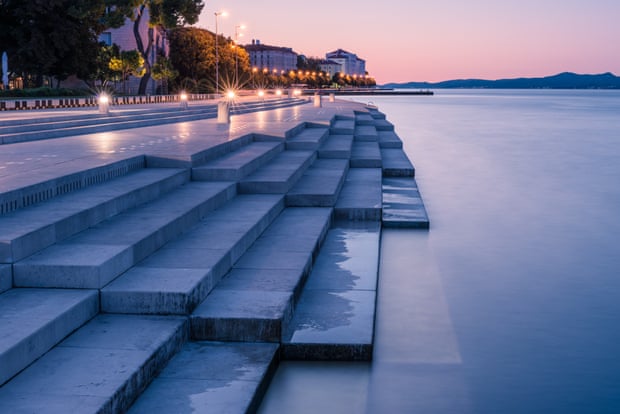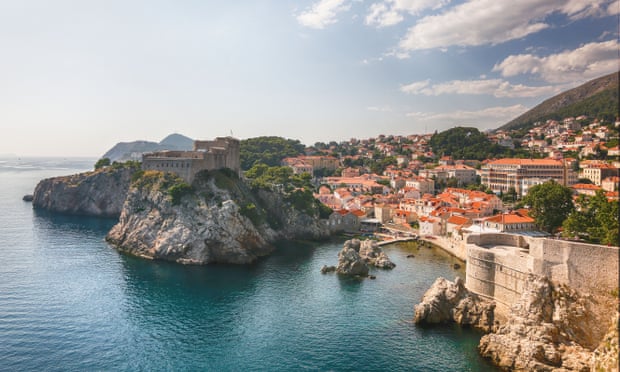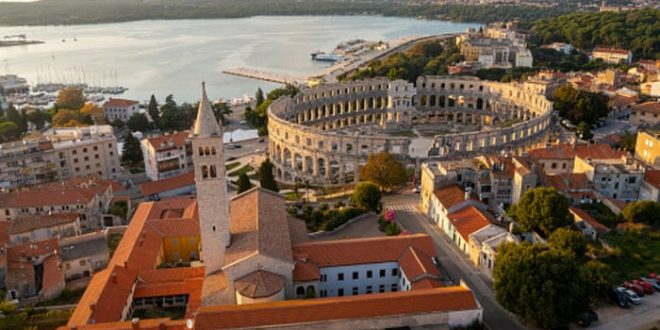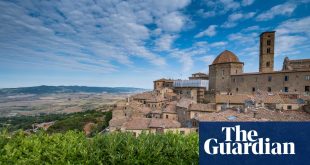From ancient archaeological sites to quirky contemporary art galleries, Croatia offers a vast range of cultural attractions for interested holidaymakers. Each summer, visitors can also expect a lively programme of open-air cultural events, showcasing Croatian artists, actors, dancers and musicians, as well as their contemporaries from abroad. Here are 10 highlights.
Roman monuments: the Arena and Diocletian’s Palace
Built between 27BC and 68AD, the Arena in Pula is a monumental Roman amphitheatre, comparable to the Colosseum in Rome. Designed to seat some 20,000 spectators, it was originally used for gladiator fights at a time when Christianity was outlawed. Nowadays it hosts more peaceful entertainment with an exciting agenda of open-air summer concerts, with the Arctic Monkeys and Tame Impala both playing in August 2022. Another truly magnificent Roman relic is Unesco-listed Diocletian’s Palace in Split. Built in the third century AD as the retirement home for Roman emperor Diocletian, its ancient walls now contain Split’s pedestrian-only old town – a fascinating labyrinth of stone alleys and Baroque palazzi.
Modern sculpture: Meštrović Gallery
A 20-minute walk west of Split’s old town, along the coast and past the ACI sailing marina, brings you to the charming Meštrović Gallery. Housed in a 1930s’ summer villa built by Croatia’s greatest 20th-century sculptor, Ivan Meštrović, it displays his sculptures formed from wood, marble and bronze, both indoors and in the garden overlooking the sea. The imposing bronze figure of Grgur Ninski, in front of Split’s Zlatna Vrata (Golden Gate), is also by Meštrović. If you visit Zagreb, be sure to visit the Meštrović Atelier, and if you’re in Cavtat, check out his enchanting Račić Mausoleum.
Film: Motovun and Pula film festivals
Each year in July, the tiny fortified hilltown of Motovun attracts thousands of film buffs, as its medieval walls host the Motovun film festival (26-30 July 2022). Featuring arthouse movies by big names such as Spike Lee and Lars von Trier, as well as showcasing lesser-known young directors, it’s the perfect way to get ahead of the cultural curve. Also in Istria, the Pula film festival (16-24 July 2022) takes place in the magnificent Roman Arena, bringing contemporary culture to an ancient setting.
Early churches: Euphrasian Basilica
Splendid glittering golden Byzantine mosaics decorate the apse of the Unesco-listed Euphrasian Basilica in Poreč. Depicting Christ on a throne accompanied by his 12 apostles, and the Virgin in heaven surrounded by angels, they date back to the sixth-century, with other features including a colonnaded atrium and octagonal baptistery. Other remarkable Christian monuments include the diminutive Church of the Holy Cross in Nin, the Romanesque churches in Zadar, and the Unesco-listed cathedrals in Trogir and Šibenik, complete with beautifully carved stone portals.
Modern art: Museum of Modern and Contemporary Art
Rijeka was European Capital of Culture 2020, which led to a flurry of cultural activity in the port city and the initiation of various building projects. The most notable is the opening of the new Museum of Modern and Contemporary Art in a former factory complex. Its collection includes works by Croatian and international artists from the 20th century onwards, including painting, sculpture and video installations. It also stages noteworthy temporary exhibitions.

Art installations: the Sea Organ and the Greeting to the Sun
If you’re in Zadar’s old town, be sure to pass by the ingenious waterside Sea Organ by local architect Nikola Bašić. Installed in 2005, it’s built into the seafront promenade as a flight of stone steps, and hums and wails, powered by the ebb and flow of the tide. Nearby, on the tip of the old town peninsula, the Greeting to the Sun (2008), also by Bašić, uses solar power to illuminate a coloured pavement installation each evening at dusk. Magical.
Arts festivals: Dubrovnik summer festival and Split summer festival
Running, more or less, side by side, the Dubrovnik and Split summer festivals are both brilliant celebrations of live performance. The Dubrovnik summer festival, which kicked off on 10 July, takes place at various open-air locations in Dubrovnik’s Unesco-listed medieval-walled old town, and runs till 25 August. Expect an impressive programme of world-class concerts and theatre; the perennial highlight is a performance of Shakespeare’s Hamlet at the mighty 14th-century Lovrijenac Fortress – not to be missed!
Meanwhile, the Split summer festival is also now underway and runs until 14 August. Standard highlights include performances of Verdi’s opera Aida on the Roman peristil within the walls of Diocletian’s Palace, and concerts and ballet on Sustipan peninsula and in the gardens of the lovely Meštrović Gallery. Each year brings some new surprises, so check out the 2022 programme as soon as you can.

City fortifications: Dubrovnik old town
Any first-time visit to Dubrovnik should begin with a full-circuit walk around the ramparts, for views over the terracotta rooftops of the Unesco-listed old town and out to sea. Through the centuries, the medieval walls were reinforced with towers and bastions, protecting the city from invasion. In fact, during the middle ages, most coastal settlements were fortified. The Venetian empire lived in fear of the Ottoman Turks and built city walls to protect its grand ports, such as Zadar and Šibenik, and harbours on the islands, such as Hvar Town and Korčula Town. In inland Istria, romantic hilltowns such as Motovun and Grožnjan were also fortified against incursion.
Conceptual art: Museum of Broken Relationships
Even those who don’t generally enjoy museums tend to fall for Brokenships – a quirky museum in Zagreb, documenting love stories that went wrong. Founded by two local artists – who used to be in a relationship together – the museum displays ordinary objects that took on a special significance during a romance, contributed by members of the public from around the world.
Discover the true beauty and diversity of Croatia for yourself this summer. To plan your perfect Croatian holiday, head to croatia.hr/en-gb/nature
 Top Naija News – Nigeria News, Nigerian News & Top Stories Top Naija News – Nigerian Newspapers, Nigerian News. topnaijanews is a daily Nigerian newspaper covering Latest News, Breaking News, Entertainment, Sports, Lifestyle and Politics.
Top Naija News – Nigeria News, Nigerian News & Top Stories Top Naija News – Nigerian Newspapers, Nigerian News. topnaijanews is a daily Nigerian newspaper covering Latest News, Breaking News, Entertainment, Sports, Lifestyle and Politics.




